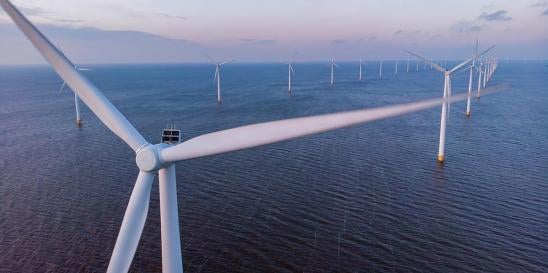On November 22, 2023, the Internal Revenue Service and Treasury Department released proposed regulations (the Proposed Regulations) relating to the investment tax credit (the ITC) under Section 48 of the Internal Revenue Code of 1986, as amended (the Code). The Proposed Regulations would amend certain existing Treasury Regulations that define the scope of ITC-eligible property (referred to as “energy property”) and general qualification for the ITC. The Proposed Regulations include detailed guidance that, if finalized in its current form, would be relevant to offshore wind developers seeking to claim the ITC for their respective projects. Nonetheless, the Proposed Regulations leave open several significant questions, including applicability to novel approaches to interconnection and project ownership. What follows are some brief observations concerning the Proposed Regulations’ applicability to offshore wind development and related open questions.
Scope of ITC-Eligible Energy Property
Consistent with prior ITC guidance, the Proposed Regulations define energy property as either (1) a “unit of energy property,” which is defined to include all functionally interdependent components of property owned by the taxpayer that are operated together and that can operate apart from other energy properties within a larger energy property or (2) any item of property that is an integral part of the energy property. As applied to offshore wind projects, functionally interdependent means that the placing in service of each component is dependent on the placing in service of the other components in order to generate electricity. Property owned by a taxpayer is an integral part of energy property owned by the same taxpayer if it is used directly in, and is essential to the completeness of, the generation of electricity. The definition of “qualified investment property,” including an ITC-eligible offshore wind facility, generally would be parallel.
In an example, the Proposed Regulations provide that the costs of the offshore wind components, if owned by a single taxpayer, between the turbine on one side and the transformer and switchgear housed in the onshore substation on the other side, including subsea export cables, would be included in the federal income tax basis of the offshore wind facility for purposes of determining the ITC. All such components are either functionally interdependent components of an energy property or integral parts of an energy property. By contrast, transmission and distribution equipment beyond the transformer and switchgear, including interconnection upgrades, would not be included.[1]
This example, though helpful, assumes the radial interconnection approach – utilized by most offshore wind projects currently under development – would be applied. Although the Proposed Regulations speak to joint ownership of energy property in certain circumstances, as discussed further below, the Proposed Regulations do not provide direct guidance regarding the eligibility of project components in the context of coordinated transmission solutions (ex., meshed-ready, backbone transmission, shared export cables, etc.) currently being pursued by many states. While the Proposed Regulations address analogous structures, further guidance and fact-specific analysis may be needed to determine the eligibility of projects that utilize these approaches.
Eligibility of Components Owned by Multiple Parties
The Proposed Regulations acknowledge that multiple parties may hold undivided ownership interests (i.e., as tenants in common) in a single energy property. In this case, each party generally is eligible for the ITC to the extent of the party’s interest in the energy property. However, the Proposed Regulations also impose a significant limitation: a taxpayer (or one or more related taxpayers) must own at least a fractional interest in the entire unit of energy property for an ITC to be determined with respect to the taxpayer’s interest. By contrast, if a taxpayer owns a unit of energy property and a second taxpayer owns property that is an integral part of that energy property, the first taxpayer remains eligible to claim the ITC with respect to its energy property, but the second taxpayer may not claim the ITC with respect to the integral part.
The preamble to the Proposed Regulations (the Preamble) provides additional guidance to illustrate this rule. The Preamble explains that if one taxpayer owns only power conditioning and transfer equipment that is an integral part of a second taxpayer’s offshore wind facility, the first taxpayer would not be eligible for the ITC with respect to the power conditioning and transfer equipment. But, if the second taxpayer holds an undivided ownership interest in the power conditioning and transfer equipment, that taxpayer would be eligible for the ITC to the extent of its interest.
As applied to coordinated transmission solutions, the Proposed Regulations may prevent a third-party developer of a coordinated transmission solution from being eligible for the ITC because it does not own a unit of energy property. However, if an owner of an offshore wind facility also owns an undivided ownership interest in the coordinated transmission solution, the owner should be eligible for the ITC in connection with such undivided ownership interest, if, as would be expected, the facility is deemed to be a unit of energy property. Similarly, if each of the two owners of separate and distinct offshore wind facilities owns an undivided interest in shared power conditioning and transfer equipment, each owner should be eligible for the ITC in connection with such undivided ownership interest. Therefore, each taxpayer would claim the full ITC in connection with its larger offshore wind facility, excluding, for this purpose, the shared power conditioning and transfer equipment for which each taxpayer could claim the ITC up to its own undivided ownership interest in the shared power conditioning and transfer equipment.
It is important to note that an offshore wind project’s chosen ownership arrangement of shared interconnection facilities could raise separate Federal Energy Regulatory Commission compliance considerations that must be evaluated in parallel with a chosen ITC strategy.
Eligibility Based on Project Timing and Prior Investments
The Proposed Regulations are intended to apply to property placed in service during a taxable year beginning after the publication of the final regulations. However, taxpayers generally are permitted to rely on the Proposed Regulations provided that any such taxpayer applies them consistently and in their entirety. Importantly, many states, including those with currently open solicitations, require that some or all “incremental” tax benefits be returned to state ratepayers. Therefore, developers should consider how best to communicate their federal tax assumptions in response to the Proposed Regulations through the solicitation process and protect these benefits in the offtake negotiations with the state.
As provided in prior ITC guidance, offshore wind projects that began construction[2] before January 29, 2023, are eligible for the ITC at the 30 percent rate without needing to satisfy the prevailing wage and apprenticeship requirements created under the Inflation Reduction Act of 2022 (the PWA Requirements). Accordingly, project owners that made substantial construction progress and/or investment in project development before January 29, 2023, should be able to include these activities for purposes of determining that construction began before such date.
The Proposed Regulations also clarify that a taxpayer that has satisfied the PWA Requirements with respect to an offshore wind project and successfully caused the ITC rate to be increased from 6 percent to 30 percent, but fails to satisfy the prevailing wage requirements during the five-year recapture period, is subject to recapture of a portion of the increased ITC. However, taxpayers may utilize the correction and penalty provisions to cure failures to pay prevailing wages within such period.
These questions spotlight areas for deeper reading and analysis—as well as dialogue with the Treasury and IRS. Public comments on the Proposed Regulations are due Monday, January 22, 2024. Solicitations in Connecticut, Massachusetts, New York, and Rhode Island require bid submissions in late January 2024.
[1] Section 48 of the Code generally provides an ITC for tangible property incorporated into a transmission or distribution system required at or beyond the point of interconnection, but only if the property is installed with respect to energy property which has a maximum net output of 5 megawatts or less (as measured in alternating current). Given the size and scope of the typical offshore wind project, interconnection costs are unlikely to be eligible for this ITC.
[2] A taxpayer may demonstrate that a project has begun construction by (1) demonstrating that physical work of a significant nature has commenced with respect to the project or (2) paying or incurring 5 percent or more of the total cost of the project. A taxpayer only needs to satisfy one of the two methods to demonstrate that the project began construction.




 i
i


